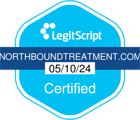Each person who uses cocaine has a slightly different reaction to it. As a stimulant, cocaine generally makes people feel energetic, happy, and talkative. On the surface, this may not seem like an abnormal or negative reaction, but this high is followed by a depressed low as soon as the stimulant drug wears off. This drastic change in behavior may involve aggression, irritability, and paranoia.
For chronic users of cocaine, the signs and symptoms are generally easier to spot. Cocaine has had time to affect the brain and body in ways that may not be perceptible in someone who has used it once or twice. However, each time carries equal risk, and continued use can result in the need for addiction treatment at a rehabilitation center. Here are five signs of cocaine abuse that are most commonly observed.
#1: Drastic Mood Swings During a Short Period of Time
The euphoria felt from cocaine use is not long lasting. When snorted, it typically lasts for 15 to 30 minutes and when smoked, it may last 5 to 10 minutes. During this time is when a person feels on top of the world. They may feel like they have laser focus and are running on all cylinders. They may feel like they require less sleep and nutrition since energy levels are up and appetite is suppressed.
On the flip side, when the feeling wears off, it then creates a slump rather than calibrating back to normal. A person may suddenly turn angry or violent. Depression and anxiety are also common. As a result of entering this dark place, they’ll do anything to feel the high again and continue to use cocaine.
As frequency of use is increased, the body forms a tolerance to the drug. This is when it requires more of the same in order to achieve the feeling as before. Eventually, this causes the brain to rely on cocaine versus its natural chemicals like dopamine to release reward sensations, such as pleasure and relaxation. This continued use ultimately leads to addiction when the brain cannot function without having cocaine in the system.
Frequent mood swings are only one of the many signs of cocaine use, but are one of the most prevalent especially for people who aren’t normally as energetic and outspoken and who do not normally behave violently or with anger. It goes beyond having a bad day or turning over a new leaf with a positive outlook. The highs and lows of cocaine abuse are far more dramatic and dangerous.
#2: Internal and External Physical Damage to the Body
There are several physical changes that take place when abusing cocaine. These include dilated pupils, slowed breathing, and seizures. Other cocaine addiction symptoms that happen internally are nausea, high blood pressure, rapid heart rate, and respiratory complications, among others. For those snorting cocaine, this can cause regular nosebleeds and damage to the nasal septum. It can also cause someone to constantly have a running nosy or sniffle frequently.
When injecting cocaine, the needles can cause bruising at the injection sites, as well as leave track marks. Sometimes these are hidden by those who use cocaine often and aren’t immediately apparent to friends and family. This also puts those who are abusing cocaine at risk for blood-transmitted disease like hepatitis C and HIV. Symptoms of these diseases may not formulate for several months after a person’s already reached the state of cocaine addiction.
#3: Interpersonal Problems at Work or Among Family and Friends
Changes in behavior in addition to dealing with harmful physical side effects as a result of drug abuse can lead to interpersonal problems. It may cause a lack of accountability and responsibility at work, putting your job in jeopardy. It can ruin friendships as you become reclusive or withdrawn. Or, if loved ones want you to stop using and you don’t want to, this can create a gap in relationships.
The way that cocaine affects the brain and keeps it from making rational decisions and following good judgment can cause you to become violent or instigate situations that lead to legal problems as well. This may include driving under the influence, starting a fight, or engaging in other risky behavior.
There is no part of your life that cocaine doesn’t negatively affect, especially if you struggle with addiction. It may start out with only one or two uses, but can quickly lead to cravings, creating the addiction without you even realizing it. In some cases, interpersonal problems you create through cocaine abuse and addiction may be irreversible.
#4: Presence of Drug Paraphernalia
Perhaps one of the most obvious signs of cocaine abuse is drug paraphernalia. This may include the presence of:
- Used needles
- Flat surfaces like a small mirror with residual white powder
- Glass pipes
- Containers and baggies with white residue
- Other instruments and evidence of cocaine use
While many hide paraphernalia from friends and family members, sometimes it is discovered or left out, especially as addiction takes over.
This evidence in combination with mood swings or other physical changes can be a convincing sign of cocaine abuse. It can be difficult to confront someone when finding paraphernalia and may require a scheduled intervention among close friends and family. If you are worried about a person you care about abusing drugs, consider seeking guidance from a treatment center for ways to approach the situation.
Having a solution in place can be helpful to give your loved one a positive choice and support to detox and abstain from drug use. With drug addiction of any kind, it’s difficult for those experiencing it firsthand to see there’s a problem or that there’s a solution that will work for them. The drug makes them feel so good the alternative doesn’t seem feasible.
#5: Withdrawal Symptoms and Relapse
Addiction doesn’t occur right away with substance abuse. However, when it is present, there are obvious withdrawal symptoms that can cause a person to easily relapse due to the pain and discomfort. These affect the whole body, both physically and mentally.
Shakiness, lethargy, night sweats, and strong cravings are all common physical symptoms. Racing thoughts, confusion, disorientation, irritability, and hallucinations are also common. These begin within a few hours after the last dose and last for several days.
They are usually the most severe in the first 24 hours and begin to taper off after a day or two. For some, they can last for weeks, though not as intensely. It depends on how long you’ve been using cocaine, your age, and current health.
The way these withdrawal symptoms disrupt the mind and body, it makes a person want to continue to use. Going through the process alone is not as successful because cravings are too strong, making relapse inevitable. In addition, your current environment likely serves as a temptation with accessibility to cocaine. Rather than trying to detox on your own, it’s best to seek the help of a medically managed drug detox program.
The body is unpredictable both when using cocaine and withdrawing from it. The effects of cocaine abuse on the body is tremendous as it disrupts the brain’s communication functioning, which can wreak havoc in multiple ways. Under the supervision of a detox program, you’ll have continuous support and medical monitoring in a safe space to keep you as stable as possible. It also gives you a much better chance of avoiding relapse.
Who Is Susceptible to Cocaine Abuse?
Anyone and everyone can fall victim to substance abuse. Using it in any form at any frequency will cause one or more of the above-mentioned signs and symptoms. Even if it’s a person’s first time to use it, it still can have an extreme effect. It may cause an overdose, coma, or even death. There’s no “safe” way to approach it; cocaine is an addictive drug that’s dangerous to all.
To go through the detox process safely and in a secure environment, find out how to treat cocaine addiction at a drug detox facility that has the people and resources to provide the care and support you need. Abruptly stopping use of the drug can be hard on the brain and body as well. Undergoing treatment as part of an addiction recovery program will provide you with constant care and a strategy for how to tackle addiction and prevent it from coming back in the future.
Cocaine abuse and addiction affects everyone. It affects the person who is using it and the people who love them. It may seem scary and impossible to escape the addiction, but it is achievable. With a treatment plan that’s customized to your specific history of cocaine abuse and goals for the future, it will take time to heal, but every day you’ll become closer to your new, sober way of living.
Through rehab, outpatient care, and addiction support services, you’ll receive the tools and accountability needed to learn how to independently handle your sobriety and maintain it even after you’ve completed treatment. It’s not a quick and fast solution, but rather a slow and intentional process to uncover your triggers and reasons for using the first place.
By getting to the root of your cocaine addiction, rather than treating it at the surface, it provides a better path to prevent it from recurring again. It gives you the opportunity to lead a happier, healthier life without the addictive trap of cocaine.
Sources:
- Gabbey, Amber Erickson. “Cocaine Addiction: What It Is, Treatment, and More.” Healthline.com. N.p., 30 Sept. 2013., https://www.healthline.com/health/cocaine-and-related-disorders
- “Drug Addiction (Substance Use Disorder) – Symptoms and Causes – Mayo Clinic.” Mayoclinic.org. N.p., 26 Oct. 2017., https://www.mayoclinic.org/diseases-conditions/drug-addiction/symptoms-causes/syc-20365112











